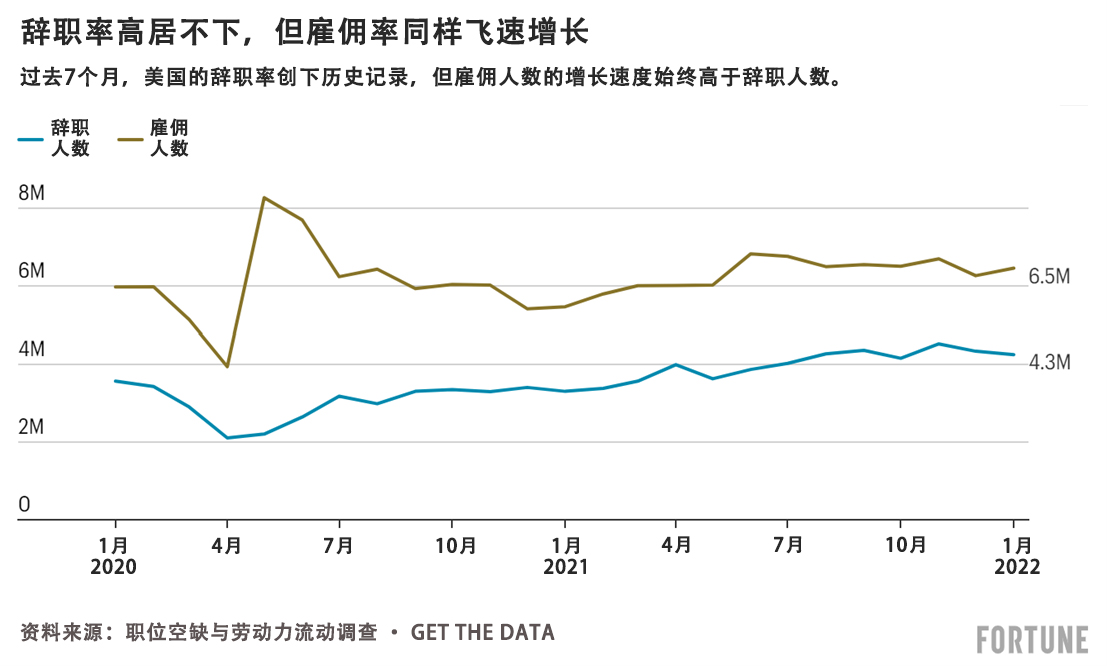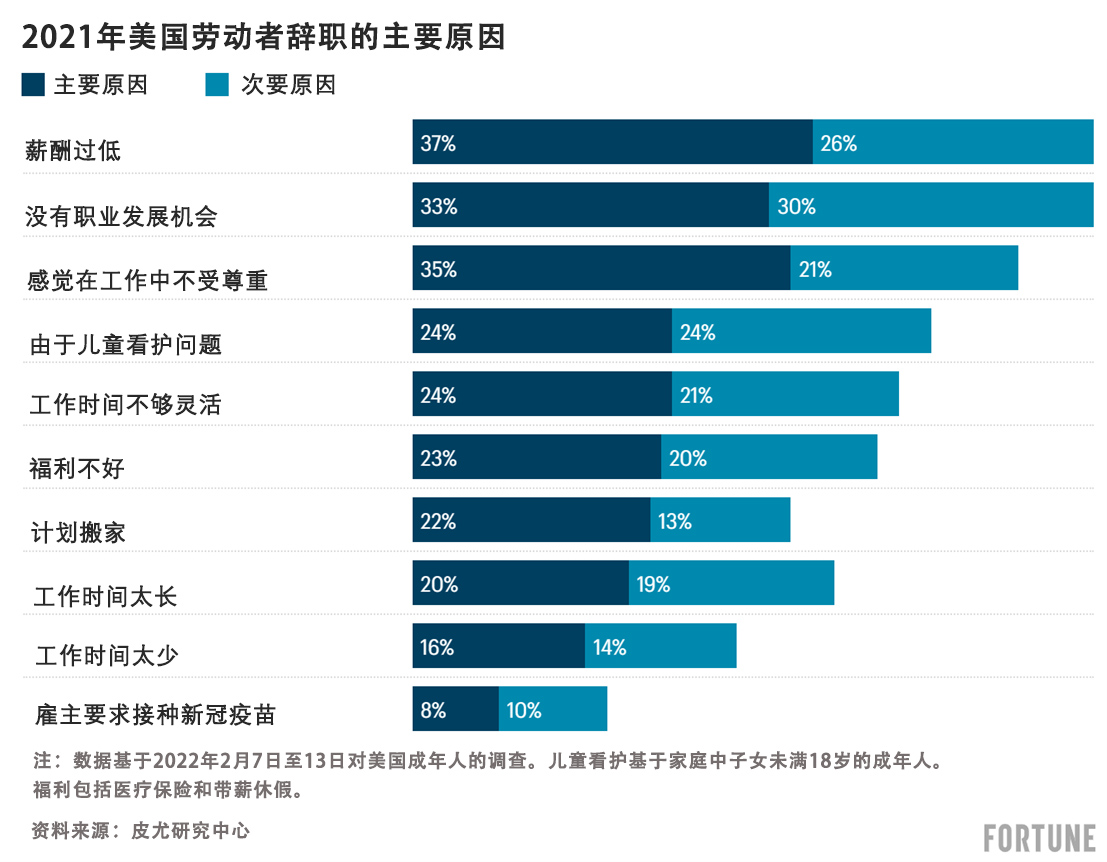2021年夏天的大辞职浪潮让经济学家和CEO们感到震惊,当时每个月有400万美国人辞职。
7个月后,这种情况并没有结束。
有早期数据显示,许多人辞职后在新工作中获得了更高薪酬、更灵活的办公时间和更多职业发展机会,所以大辞职浪潮延续到2022年并不奇怪。
自2021年7月以来,每个月有至少400万美国人辞职。劳工统计局周三发布的最新职位空缺与劳动力流动调查报告显示,1月约430万人辞职,约占工作人口的2.8%。
这比去年11月减少了约27.5万人。当时,美国人的辞职率达到自劳工统计局2000年启动该项调查以来的最高水平。

辞职有好处
对许多人来说,辞职能带来回报。皮尤研究中心(Pew Research Center)调查的美国成年人中,有超过一半(56%)表示其新工作的收入更高。大部分受访者还表示,他们现在的工作时间更灵活,有更好的职业发展机会,更容易保持工作和生活平衡。
皮尤调查发现,在2021年促使美国劳动者辞职的首要原因是低薪酬(63%),其次是缺少职业发展机会和在工作中感觉“不受尊重”。
劳工统计局上周发布的就业报告显示,过去12个月,美国平均时薪上涨约5%,上个月非农业工人的时薪达到31.58美元。这给许多公司带来了压力,因为他们除了为吸引和留住员工而被迫加薪以外,还需要面对经营成本增加、通货膨胀和供应链挑战等诸多问题。美国经济咨商会调查发现,2022年,公司整体计划将员工工资提高3.9%。
但公司面临的困难,至少在目前对员工而言是好消息。皮尤研究副主任朱莉安娜·霍洛维茨告诉《财富》杂志:“我们确实看到了一些改善。我们知道低薪和缺少发展机会是人们选择辞职的主要原因。因此,有许多人表示在当前的工作中获得了更高薪酬和更多发展机会,这绝对是一种进步。”
皮尤的一项最新调查发现,有约五分之一未到退休年龄的工作者选择在去年某个时间辞职。皮尤调查发现,换工作在年轻工作者(18至29岁)和低收入美国人当中更为普遍。
虽然大多数工作者认为雇主在许多领域有所改进,但福利并没有太大变化。有43%的工作者将福利问题列为辞职原因。超过三分之一工作者表示新工作提供的福利与之前的福利几乎相同,有22%的工作者表示福利变得更差。
拥有学位的工作者工资上涨的情况更为普遍。66%接受过大学教育的受访者表示目前收入增加,而没有学位的受访者比例为51%。(财富中文网)
译者:刘进龙
审校:汪皓
2021年夏天的大辞职浪潮让经济学家和CEO们感到震惊,当时每个月有400万美国人辞职。
7个月后,这种情况并没有结束。
有早期数据显示,许多人辞职后在新工作中获得了更高薪酬、更灵活的办公时间和更多职业发展机会,所以大辞职浪潮延续到2022年并不奇怪。
自2021年7月以来,每个月有至少400万美国人辞职。劳工统计局周三发布的最新职位空缺与劳动力流动调查报告显示,1月约430万人辞职,约占工作人口的2.8%。
这比去年11月减少了约27.5万人。当时,美国人的辞职率达到自劳工统计局2000年启动该项调查以来的最高水平。
辞职有好处
对许多人来说,辞职能带来回报。皮尤研究中心(Pew Research Center)调查的美国成年人中,有超过一半(56%)表示其新工作的收入更高。大部分受访者还表示,他们现在的工作时间更灵活,有更好的职业发展机会,更容易保持工作和生活平衡。
皮尤调查发现,在2021年促使美国劳动者辞职的首要原因是低薪酬(63%),其次是缺少职业发展机会和在工作中感觉“不受尊重”。

劳工统计局上周发布的就业报告显示,过去12个月,美国平均时薪上涨约5%,上个月非农业工人的时薪达到31.58美元。这给许多公司带来了压力,因为他们除了为吸引和留住员工而被迫加薪以外,还需要面对经营成本增加、通货膨胀和供应链挑战等诸多问题。美国经济咨商会调查发现,2022年,公司整体计划将员工工资提高3.9%。
但公司面临的困难,至少在目前对员工而言是好消息。皮尤研究副主任朱莉安娜·霍洛维茨告诉《财富》杂志:“我们确实看到了一些改善。我们知道低薪和缺少发展机会是人们选择辞职的主要原因。因此,有许多人表示在当前的工作中获得了更高薪酬和更多发展机会,这绝对是一种进步。”
皮尤的一项最新调查发现,有约五分之一未到退休年龄的工作者选择在去年某个时间辞职。皮尤调查发现,换工作在年轻工作者(18至29岁)和低收入美国人当中更为普遍。

虽然大多数工作者认为雇主在许多领域有所改进,但福利并没有太大变化。有43%的工作者将福利问题列为辞职原因。超过三分之一工作者表示新工作提供的福利与之前的福利几乎相同,有22%的工作者表示福利变得更差。
拥有学位的工作者工资上涨的情况更为普遍。66%接受过大学教育的受访者表示目前收入增加,而没有学位的受访者比例为51%。(财富中文网)
译者:刘进龙
审校:汪皓
The Great Resignation shocked economists and CEOs alike in the summer of 2021 when 4 million American workers started quitting their jobs every month.
Seven months on, it’s still happening.
And why shouldn’t it spill into 2022, when data clearly shows that this many quits likely leads to workers seeing better pay, more flexibility, and greater opportunities for career growth at their new jobs?
At least 4 million Americans have quit their jobs every month since July 2021. In January, about 4.3 million Americans, or 2.8% of workers, walked out the door, according to the latest Job Openings and Labor Turnover report from the Bureau of Labor Statistics released Wednesday.
That’s down by about 275,000 resignations from November, when the quit rate hit the highest level recorded by the BLS since the survey launched in 2000.
It pays to quit
For many, quitting paid off. Over half, or 56%, of U.S. adults surveyed by Pew Research Center say they’re earning more money at their new job. A majority also noted they now had more flexibility around their work hours, better opportunities for career growth, and an easier time juggling work/life balance.
Among the reasons U.S. workers cited as prompting them to quit in 2021 were low pay (63%), followed by a lack of career advancement opportunities and feeling “disrespected” at work, Pew found.
The average hourly wage has crept up by about 5% over the past 12 months, hitting $31.58 for nonfarm workers last month, according to the Bureau of Labor Statistics employment report issued last week. That’s created a squeeze for companies, many of whom are battling higher operating costs, inflation, and supply-chain challenges—in addition to being forced to raise wages to attract and retain employees. Overall, companies are set to increase worker wages by 3.9% in 2022, according to the Conference Board.
But what’s proved a struggle for companies is good news for workers—at least for now. “We definitely see improvements for sure,” Juliana Horowitz, associate director of research with Pew, tells Fortune. “We know that low pay and the lack of opportunities for advancement, were among the top reasons why people said they quit. And so the fact that sizable shares of people say that they have more of these things—they have higher pay and more opportunities in their current job—is definitely an improvement.”
About one in five U.S. workers who haven’t yet retired quit their jobs at some point last year, according to a new survey from Pew. Changing jobs was much more prevalent among younger workers (those ages 18 to 29), as well as lower-income Americans, Pew found.
But while most workers saw employer offerings improve in a number of areas, benefits—which 43% of workers cited as a reason to leave—were one factor that didn’t see much change. Just over a third of workers say the benefits at their new job are about the same as their previous perks, while 22% actually report worse benefits.
And those pay increases tended to be common among those with a degree. About 66% of those with a college education say they’re now earning more compared with 51% without a degree.






